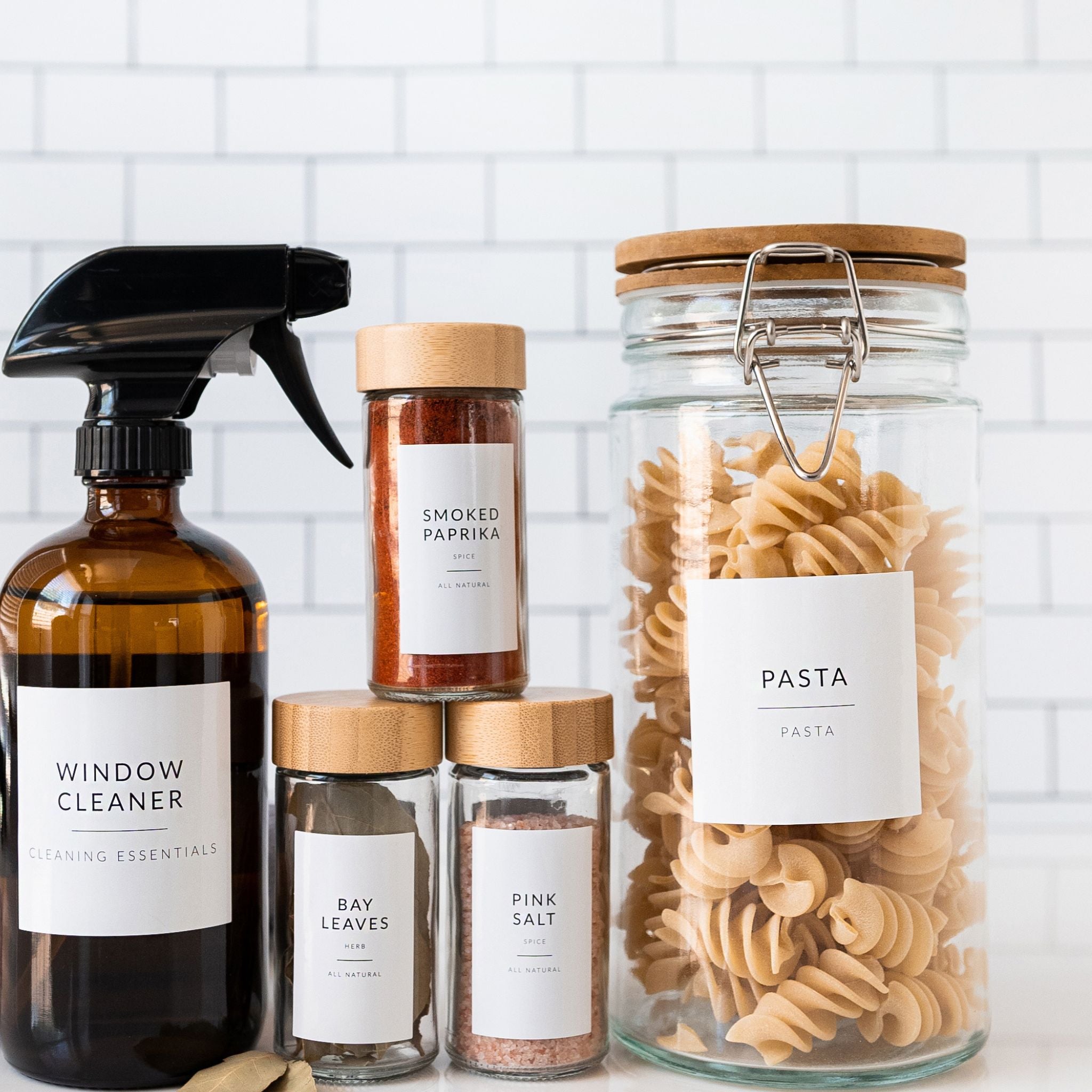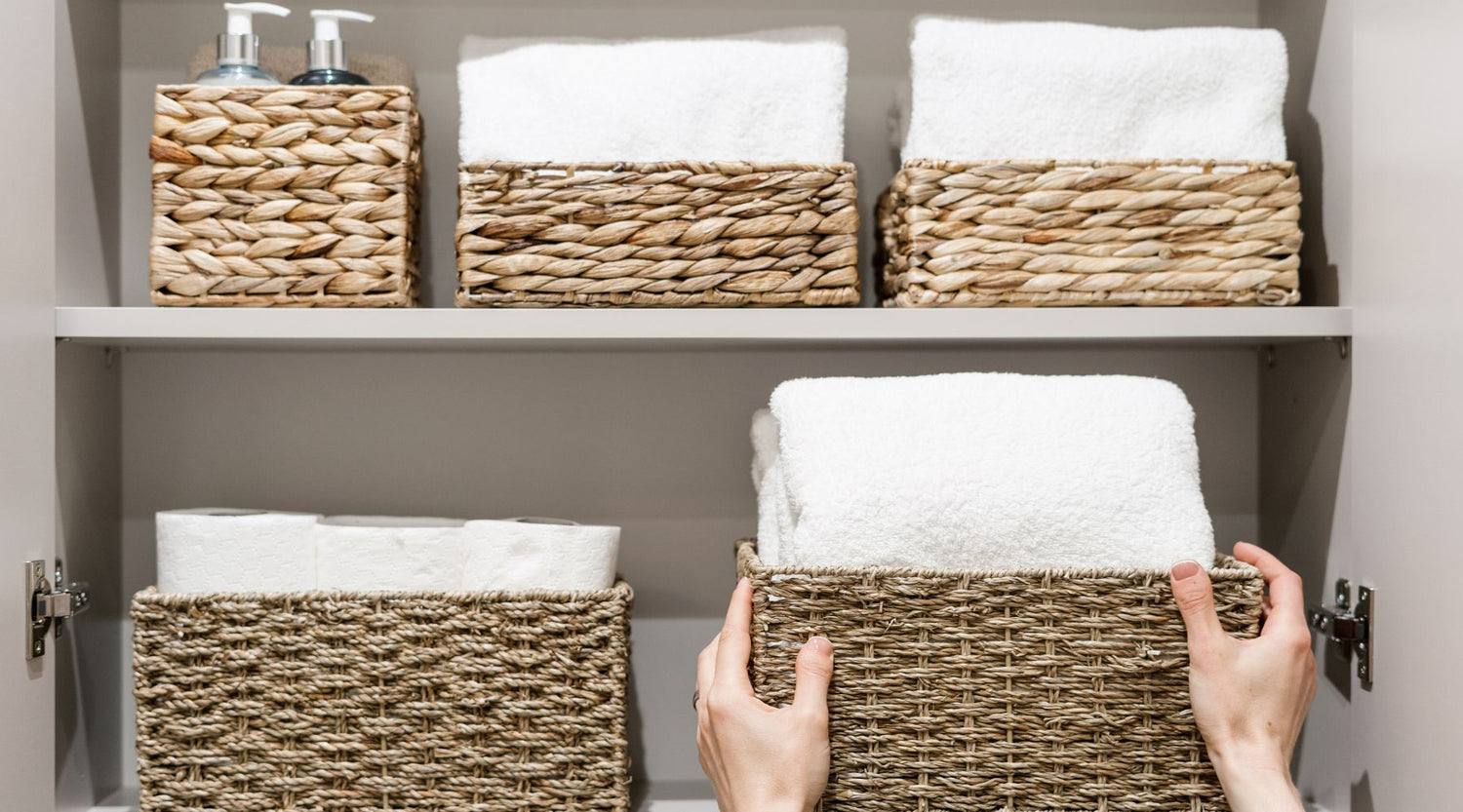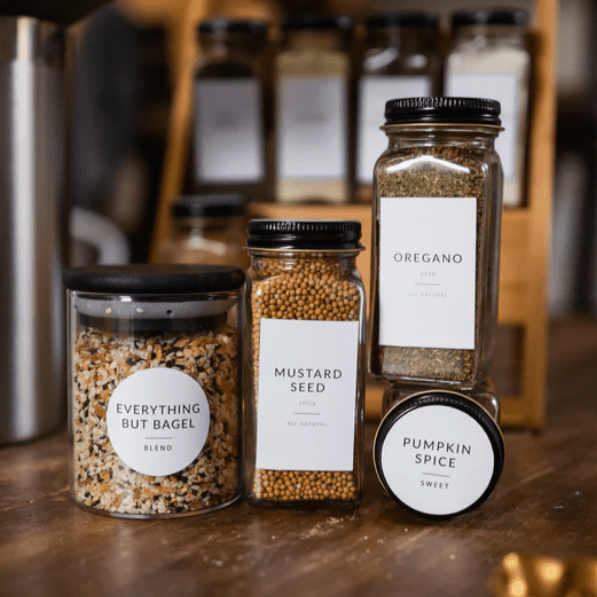Pantry labels will be your new best friend for keeping your pantry organized and your mind at ease.
Quick links:
You should grab some of our pantry labels and streamline your pantry system.
Save time
The first, and arguably the most beneficial aspect of a labeling system is that it allows you to locate your pantry items much faster.
When you need an ingredient for a recipe, or simply want to grab a snack, you don't have to shuffle through a mess of storage containers and packages. One quick look and you will know where to find the item you need.
Whether it's locating the kidney beans for chili or grabbing some pretzels for a midday snack, clear labels will guide you so you can get on with your day.
A labeling system also saves you time when putting groceries away after a trip to the store. Identify the right spot for your groceries with a properly labeled pantry.
Reduce food waste
Another major benefit of having a labeled pantry system is that it helps eliminate unnecessary food waste. It's so easy to forget what you have in the back of your pantry when items are disorganized and hidden behind other packages.
Expiration dates will make it much easier to see if items are properly organized and grouped together on labeled shelves. Periodically scan your pantry and identify anything that needs to be used up. Efficient rotation of stock and visibility of expiry dates will help you use items while they are still fresh and avoid wasting food.
Clear labels prevent forgotten ingredients from being left unused. When you can see all of the food you have available, you are more likely to find ways to use them before they spoil.
Prevent duplicate purchases
With a clear labeling system, you have full visibility of your grocery supply. One simple glance at your "canned goods" or "baking items" will refresh your memory. This makes it less likely for you to unintentionally purchase unnecessary duplicates when you hit the store.
Before you go to the store, check the status of pantry staples such as beans, dairy products, tomatoes, pasta, rice, oils, etc. Make a note of anything that is running low. Take a look through your specialty ingredients such as baking supplies, condiments, sauces, and spices. A proper pantry labeling system makes it easy to create a thorough grocery list without doubling up on items.
Take a quick peek into your nicely organized pantry before you head to the store and make note of what needs to be replenished.. This small step will help save money on groceries.
Simplify menu planning and shopping
A clearly labeled pantry also makes planning weekly menus and shopping lists much easier. When you can easily see everything you have on hand, you can incorporate existing pantry items into recipes and identify exactly which ingredients need to be purchased or restocked.

Here is what you can do:
- Review your cans, boxes, and bottles to take a quick inventory of what you have on hand.
- Choose 2-3 recipes that creatively use up some of the items you already have.
- Identify the remaining key ingredients needed for those recipes—do you have them in stock or do they need to be purchased?
- Make your grocery list by writing down only the ingredients you need to supplement what you already have available at home.
This simple labeled pantry meal planning method will help you create menus and shopping lists effortlessly. Creatively transform available ingredients into delicious, budget-friendly meals each week.
Cook creatively, save money, and reduce food waste with food products you already have!
Save money
A properly organized pantry not only saves you time and reduces waste, it also cuts down on grocery spending.
When you can easily see what you already have in stock, you won’t over-purchase and end up with duplicate ingredients. Stop buying food items you already have and wasting those precious dollars!
Plan creative meals around existing pantry items rather than purchasing new ones. For example, use those lentils and spices you forgot about for a soup recipe instead of buying a new set of ingredients.
A labeled pantry system also enables accurate weekly inventory checks of staples such as rice, pasta, or canned tomatoes. You can easily identify when certain items are running low and need restocking. This prevents expensive last-minute purchases.
Take some time to clearly organize and label your pantry shelves with Savvy & Sorted’s pantry labels.
If you’re interested in saving money while getting organized, read our article about how to organize your pantry on a budget.
Promote household harmony
A clearly labeled pantry doesn't just help in the kitchen—it also promotes smoother interactions and better experiences for the whole household.
When family members or roommates can easily find what they need for cooking, baking, or snacking, it prevents unnecessary frustration. No more desperately searching through the pantry for a missing ingredient! Food labels help identify spots for important staples, foods with dietary restrictions, child-accessible snacks, and more.
A labeled pantry makes sharing space easier for everyone, especially in shared households. Labels can identify which items are shares, and which ones are for someone's personal use.
For example, customized labels with signs "Amy's gluten-free baking supplies" or "Kamal's energy bars" tell what exactly is inside and avoid confusion. A good labeling system promotes clarity and helps avoid arguments.
How do I label my kitchen pantry?
Labeling your pantry is simple. Here are some easy steps to follow:
- Clear everything out so you've got an empty slate to work with.
- Think about how you want to organize things—group ingredients together, fresh food, snacks, baking stuff, etc. Divide it into categories that make sense for how your family cooks and eats.
- Write the category names clearly on your labels for each section.
- You can use a sharpie and tape as a cheap but less fancy option.
- You can also buy chalkboard labels and liquid chalk markers for a timeless aesthetic.
- Preprinted pantry labels are another option. Our Black Minimalist Pantry Label set includes 194 pre-printed labels that cover all the main food categories. We also offer a set of 146 spice labels.
- Restock your pantry using your new labeling system. Place labels at eye level so they are easy to read.
And just like that - ya did it! Your pantry is now nicely organized so anyone can spot exactly what they need in a snap. Replace worn-out labels as needed and enjoy that sweet stress-free pantry!
How to organize my walk-in pantry?
To organize a spacious walk-in pantry:
- Remove all items from the shelves and sort them into food groupings such as baking ingredients, cereals, canned goods, etc.
- Restock items categorically and use vertical space efficiently with extra shelves up high for less-used items. Vertical dividers neatly separate ingredient zones.
- Install slide-out racks near the back of shelves to easily access items that otherwise get buried behind larger packages.
- Use spinning lazy susans in corners to ensure easy access to small jars and bottles that can hide in cramped spaces.
- Label all of your shelves and sections with the corresponding food categories.
Benefits of labeling FAQ
What is the importance and purpose of food labeling?
Food labels help you instantly identify ingredients in your pantry to eliminate the need to search for what you want. Labels keep things organized into logical groups like snacks, baking items, cans, etc.
This will help save money, time, and reduce food waste. Labels also promote harmony in the household by clearly marking personal vs. shared food.
Should I remove food from the original packaging?
Sometimes it makes sense to remove the original packaging if it allows items to stack neater or show expiration dates more clearly. Large bags of flour and sugar often work fine, or you can store them in glass containers. Consider whether using original food packaging or opting for containers will help you best organize your items.
Are airtight containers a good choice for kitchen cabinets?
Yes, airtight containers excel at keeping dry goods fresh for extended periods. Square containers stack perfectly, while round ones can fit better in awkward spaces. Invest in sets with airtight seals to preserve freshness for months or years.
Why is it important to have an organized pantry?
It is important to organize your pantry because hunting for ingredients wastes precious time. An organized pantry with logical labels prevents perfectly good food from being forgotten and wasted. It enables easier sharing between family members and ultimately saves you money.
Why are dry-erase markers helpful for pantry labels?
Dry-erase markers make labeling a breeze. Modify labels whenever you reorganize a shelf or want to swap ingredients. Just wipe away the old text with a damp cloth or eraser and rewrite your new label. This flexibility means your labeling system adapts as your ingredients and storage needs change over time.
Should I utilize vertical space for extra pantry storage?
Freeing up vertical storage above and below existing shelves is smart for maximizing every inch of pantry space. You can install extra shelves above shorter ones, or try stackable, modular food storage bins to maximizer space. Vertical organization opens up room for food groups like baking supplies, pasta, or canned foods that are used less frequently.
What are some creative pantry organization ideas for small spaces?
For small, cramped spaces consider these pantry organization ideas:
- Utilize vertical storage with stackable shelves and bins to double the capacity.
- Install hanging racks on the back of doors for easy access.
- Pull-out drawers maximize vertical space
- Clear plastic bins neatly organize items while keeping them visible.
- Modular, adaptable elements alongside labeling techniques help customize and organize even the most crowded pantries.






